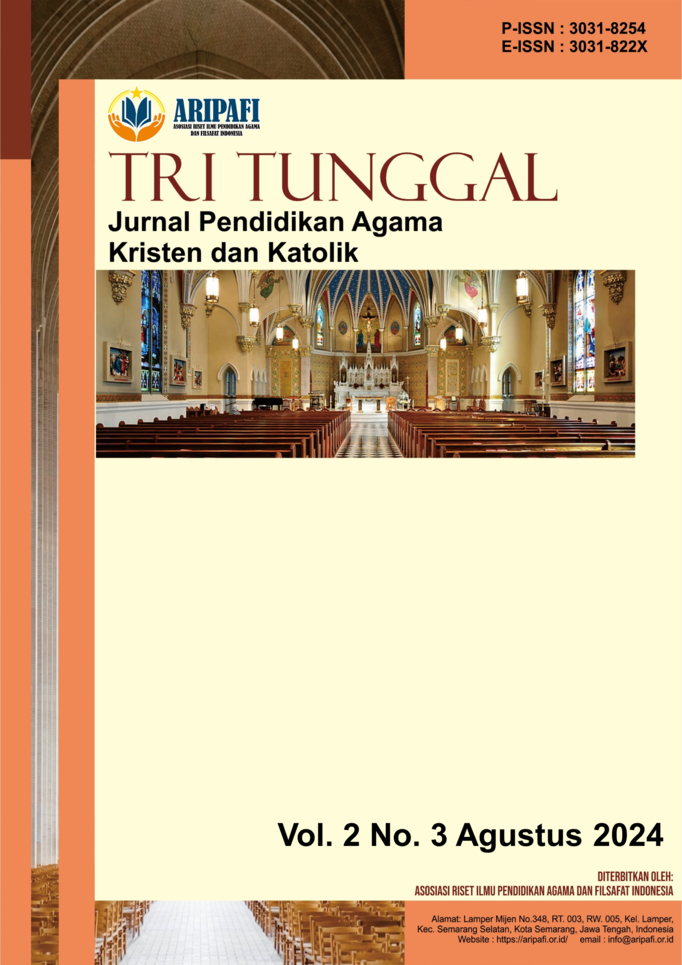Implementasi Gaya Kepemimpinan Situasional Kepala Sekolah SMKS ST.Nahanson Parapat Sipoholon
DOI:
https://doi.org/10.61132/tritunggal.v2i3.472Keywords:
Leadership style, Implementation, PrincipalAbstract
Leadership style can be defined as a collection of a person's behavior that aims to change and influence the minds of other people so that they are willing to follow the instructions and directions given. This research is a type of qualitative research that uses a descriptive approach. The aim is to explain and describe information obtained from the field as data in research. The location of this research was at SMKS St. Nahanson Parapat Sipoholon, the research subject is the principal at SMKS St. Nahanson Parapat Sipoholon. The data analysis method used refers to the theory of Miles and Huberman, which consists of several steps as follows: 1). Data Collection: Researchers collect data through interviews, observation and documentation. 2). Data Reduction: Researchers carry out selection returning to the data that has been collected at the data analysis stage. 3). Data Presentation: The reduced data is presented by the researcher at this stage. 4). Drawing Conclusions: Before drawing conclusions, the researcher double-checks the data that has been collected. Leadership is the ability and readiness of an individual to influence, encourage, invite, guide, mobilize, and if necessary force others to act in achieving organizational goals. Situational leadership is a leadership approach in which the leader's behavior is adapted to the varying conditions and situations of each subordinate. Indicators that influence situational leadership include: (a) the telling dimension, where the leader gives clear instructions when assigning; (b) selling dimension, which involves two-way communication between leaders and subordinates; (c) participating dimension, which includes assigning tasks and responsibilities to subordinates and supporting leaders in carrying out these tasks; and (d) the delegation dimension, where the leader gives authority to subordinates to act independently. At St. Mary's Vocational School Nahanson Parapat, the situational approach adapts leader behavior to specific conditions and subordinate needs, with four main styles, namely telling, selling, participating, and delegating. Situational leadership has been implemented with examples of implementation by the Principal practicing a telling approach in exam preparation, using selling in discussing new teaching scheduling, and participating in Prakerin planning. However, the delegating style is less applied because the Principal tends to control all aspects of decisions and tasks. In practice, situational leadership at St. Nahanson Parapat faces several obstacles, including the school environment and staff characteristics, which influence the effectiveness of implementing this leadership style. These obstacles require special strategies to overcome them, so that situational leadership can be more effective and adapt to existing situations, so that organizational goals are achieved optimally.
Downloads
References
Abun, A. R., Setyaningsih, R., & Pujianti, E. (2023). Implementasi gaya kepemimpinan situasional kepala sekolah di SMP N 2 Pemulutan Barat Ogan Ilir Sumatera Selatan. Unisan Jurnal, 02(04), 851–862.
Aisyah, S., & Takdir, S. (2017). Implementasi gaya kepemimpinan situasional kepala sekolah di SMP Negeri 1 Wamena Kabupaten Jayawijaya. Jurnal Kepemimpinan Dan Pengurusan Sekolah, 2(2), 119–132.
Anggayani, N. L., Noak, P. A., & Yudharta, I. P. D. (2016). Analisis gaya kepemimpinan kepala sekolah dalam meningkatkan kinerja guru (Studi kasus Sekolah Dasar Negeri 2 Pemecutan Kota Denpasar). Citizen Charter, 1(1), 1–8.
Azhar, S. (2017). Leadership of the head of effective school (Islamic education perspective). Auladuna: Jurnal Pendidikan Dasar Islam, 4(1), 20–29.
Herlina, B., Darwis, D., & Sulfiani, B. (2022). Analisis gaya kepemimpinan kepala sekolah dalam mengembangkan mutu sekolah dasar. AL-ASASIYYA: Journal Of Basic Education, 6(2), 129–138. https://doi.org/10.24269/ajbe.v6i2.5063
Ikasari, S. A., Parida, I., & Duriyah. (2022). Implementasi gaya kepemimpinan situasional kepala sekolah di MTS Islamic Center Cirebon. Jurnal Al-Naqdu Kajian Keislaman, 3(2), 1–12.
Julaiha, S. (2019). Konsep kepemimpinan kepala sekolah. Tarbiyah Wa Ta’lim: Jurnal Penelitian Pendidikan Dan Pembelajaran, 6(3), 179–190. https://doi.org/10.21093/twt.v6i3.1734
Kwirinus, D., Jando, A. M., Avi, G., Nino, M., & Ndua, Y. H. (2023). Model kepemimpinan situasional dan transformasional kepala sekolah SMAK Yos Sudarso Batu. Equilibrium: Jurnal Pendidikan, 11(1), 59–69. https://doi.org/10.26618/equilibrium.v11i1.9288
Lembaga, D. I., Pendidikan Islam, Analisis Skema, & Capaian Hambatan. (2023). Analisis skema, capaian dan hambatan. Jurnal, 4(2), 245–256.
Nabila, M., & Ghani, A. R. A. (2022). Implementasi gaya kepemimpinan situasional kepala sekolah memasuki pembelajaran tatap muka. Jurnal Basicedu, 6(3), 5115–5123. https://doi.org/10.31004/basicedu.v6i3.3040
Rahmiyanti, H. Y. (2020). Gaya kepemimpinan situasional kepala sekolah terhadap kinerja guru pendidikan Pancasila dan Kewarganegaraan (PPKn) pada SMA Negeri se Kabupaten Barito Kuala. Jurnal Terapung: Ilmu - Ilmu Sosial, 2(2), 13–22. https://doi.org/10.31602/jt.v2i2.3973
Riski, H., Rusdinal, R., & Gistituti, N. (2021). Kepemimpinan kepala sekolah di sekolah menengah pertama. Edukatif: Jurnal Ilmu Pendidikan, 3(6), 3531–3537. https://doi.org/10.31004/edukatif.v3i6.944
Sentana, I. K., & Wiyasa, I. K. (2021). Kontribusi gaya kepemimpinan situasional kepala sekolah dan resiliensi diri guru terhadap kinerja guru. MIMBAR PGSD Undiksha, 9(1), 104. https://doi.org/10.23887/jjpgsd.v9i1.32082
Siagian, H. M., Lubis, M. J., & Darwin, D. (2022). Penerapan gaya kepemimpinan situasional kepala sekolah SD swasta. Jurnal Basicedu, 6(3), 3821–3829. https://doi.org/10.31004/basicedu.v6i3.2747
Syarifudin, A., Uliya, T., & Widiastuti, N. (2023). Implementasi gaya kepemimpinan situasional kepala sekolah SMK Muktazam Gisting. Unisan: Jurnal Manajemen Dan Pendidikan, 02(03), 500–509.
Waedoloh, H., Purwanta, H., & Ediyono, S. (2022). Gaya kepemimpinan dan karakteristik pemimpin yang efektif. Social, Humanities, and Educational Studies (SHEs): Conference Series, 5(1), 144. https://doi.org/10.20961/shes.v5i1.57783
Downloads
Published
How to Cite
Issue
Section
License
Copyright (c) 2024 Tri Tunggal: Jurnal Pendidikan Kristen dan Katolik

This work is licensed under a Creative Commons Attribution-ShareAlike 4.0 International License.





